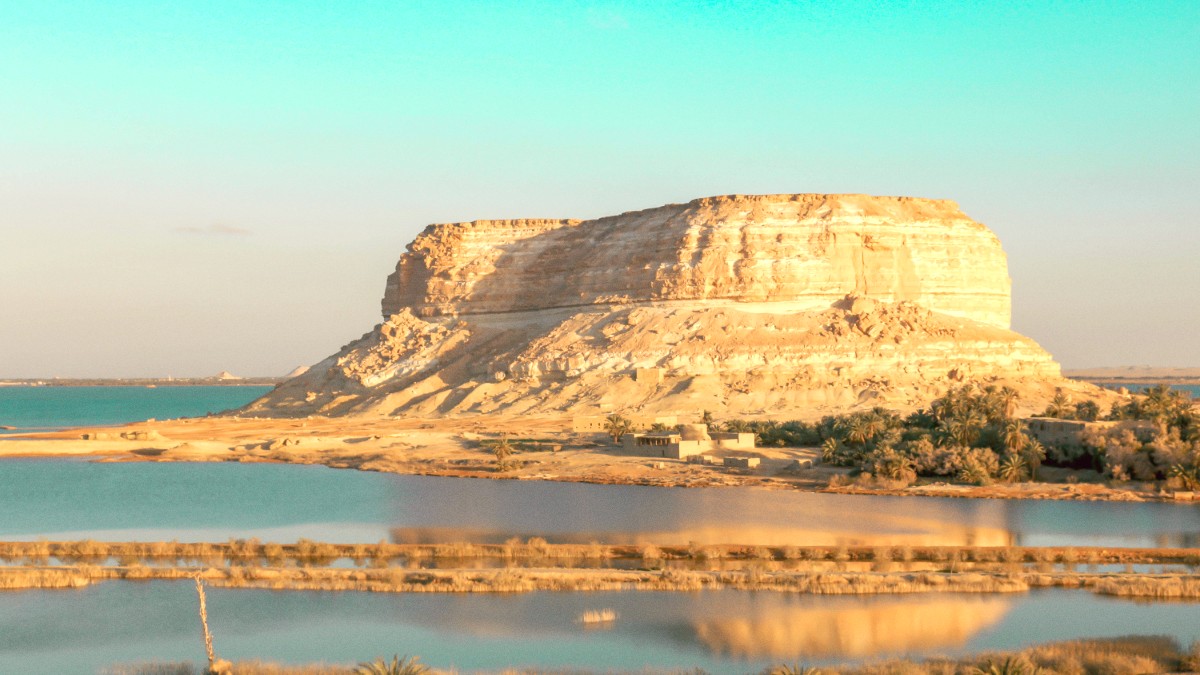
Western Desert, Egypt
Siwa's most famous sites deliver a deep dive into its history and unique natural features.
Shali is the ancient fortified town that was the heart of Siwa for centuries, built from "Kershef" (salt-rock and mud). It delivered protection against invaders and elements. Though heavy rains in 1926 caused significant damage, parts still stand, forming a striking landmark against the sky.
Visit Shali in the early morning or late afternoon for soft, golden light. Wear sturdy, closed-toe shoes as paths are uneven. Explore narrow alleys and climb to higher points for breathtaking panoramic views of the oasis.
Always book desert activities with reputable local operators for safety.
Siwa's natural landscape matches its history, featuring unique water bodies and desert formations.
Siwa has numerous large, highly saline lakes. The high salt concentration permits effortless floating, similar to the Dead Sea experience. Bring water shoes for protection, as salt crystals can be sharp.
A natural hot spring amidst the Great Sand Sea. It presents a warm, sulfuric bath experience, a surprising find. Visiting at sunset or night under clear, star-filled skies creates a distinct experience.
A refreshing contrast to Bir Wahed, Ain Gazzi is a natural cold spring. It is a suitable spot for a cool dip on a hot day, offering a tranquil environment.
Known for its healing properties, especially for rheumatism. Locals practice therapeutic sand burial here in summer. Climb for panoramic views. Sand burial is a local tradition, to be attempted with local guidance.
Vast areas of date palms and olive trees form the lush green heart of the oasis. These groves are productive agricultural lands and offer a serene environment, suitable for cycling or walking, delivering welcome shade.
Many of Siwa's natural attractions are best accessed via guided tours, especially those in the desert. Always confirm transportation arrangements when booking.
Small, local workshops where artisans craft traditional Siwan pottery. Observe the process and purchase unique pieces directly, upholding local art.
A resort island accessible by boat on Siwa Lake. It creates a secluded and peaceful experience, suitable for birdwatching and enjoying lake views away from the main town.
Explore residential areas of modern Siwa to see current mud-brick architecture. These homes feature distinct designs. Always respect privacy when observing local homes.
Discover unique cultural and natural experiences beyond the main tourist circuit.
Beyond the main tourist circuit, Siwa holds some lesser-known spots that present distinct cultural and natural experiences.
Siwa's hidden gems offer a chance for exploration away from typical itineraries. These sites connect you with authentic local life and secluded natural beauty.
Venture to these places with an open mind and a respectful approach to local customs. Many of these locations are best explored with local guidance or by engaging with the community directly.
Discover the artistry of Siwan people and see their traditions firsthand.
Find tranquility and unique landscapes away from the crowds.
The Siwa Souq is more than just a market; it's a window into daily life.
For a truly unique experience, seek out these less visited spots.
These images capture the essence of Siwa's diverse attractions, from its historical landmarks to stunning natural wonders.
The iconic Shali Fortress silhouetted against a Siwan sunset, capturing its ancient beauty and dramatic presence.
A view of the weathered ruins of the Oracle Temple, hinting at its profound historical significance and the stories within its ancient stones.
The natural spring pool, Cleopatra's Bath, showing its inviting waters and stone surroundings, a popular spot for a refreshing dip.
A person floating effortlessly on one of Siwa's crystal-clear salt lakes, emphasizing the unique buoyancy and serene environment.
A 4x4 vehicle navigating vast sand dunes in the Great Sand Sea, capturing the excitement of a desert safari adventure.
A local Siwan woman engaged in traditional crafting, showing the intricate details of local artistry and cultural heritage.
The natural hot spring of Bir Wahed in the desert, depicting its warm waters and the remote, serene desert setting.
A colorful display of Siwan dates and olives at the local market, highlighting the agricultural bounty and local produce available.
Maximizing your sightseeing experience in Siwa.
Engage with Siwa's culture respectfully.
They provide unique insights into Siwan history, culture, and nature that you might otherwise miss.
Plan your visits to Siwa's attractions efficiently to maximize your experience.
A suggested schedule for exploring Siwa's highlights.
Continuing your Siwan exploration into the cooler hours.
A dedicated day for exploring the vast Great Sand Sea.
Consider an overnight desert camp for an unforgettable stargazing experience.
cultural connections and local insights.
This day provides a genuine connection to Siwan daily life and traditions.
A day dedicated to relaxation and natural healing.
Conclude with a sunset view from a tranquil spot within the groves.
Many historical sites involve uneven terrain or stairs. Some modern accommodations have better access. Inquire with properties directly.
October to April offers pleasant weather. Summer months (June-August) are very hot, limiting daytime outdoor activities.
Allow 3-5 days to fully experience Siwa's blend of history, nature, and culture. Day trips are generally insufficient.